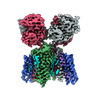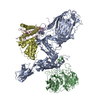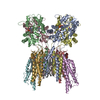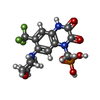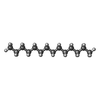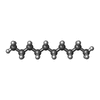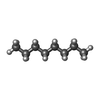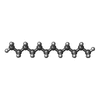[English] 日本語
 Yorodumi
Yorodumi- EMDB-23292: The composite LBD-TMD structure combined from all hippocampal AMP... -
+ Open data
Open data
- Basic information
Basic information
| Entry | Database: EMDB / ID: EMD-23292 | |||||||||
|---|---|---|---|---|---|---|---|---|---|---|
| Title | The composite LBD-TMD structure combined from all hippocampal AMPAR subtypes at 3.25 Angstrom resolution | |||||||||
 Map data Map data | ||||||||||
 Sample Sample |
| |||||||||
| Function / homology |  Function and homology information Function and homology informationPhase 2 - plateau phase / Phase 0 - rapid depolarisation / negative regulation of receptor localization to synapse / negative regulation of anterograde synaptic vesicle transport / Cargo concentration in the ER / LGI-ADAM interactions / COPII-mediated vesicle transport / Trafficking of AMPA receptors / localization within membrane / neurotransmitter receptor transport, postsynaptic endosome to lysosome ...Phase 2 - plateau phase / Phase 0 - rapid depolarisation / negative regulation of receptor localization to synapse / negative regulation of anterograde synaptic vesicle transport / Cargo concentration in the ER / LGI-ADAM interactions / COPII-mediated vesicle transport / Trafficking of AMPA receptors / localization within membrane / neurotransmitter receptor transport, postsynaptic endosome to lysosome /  L-type voltage-gated calcium channel complex / L-type voltage-gated calcium channel complex /  regulation of AMPA receptor activity / neurotransmitter receptor internalization / channel regulator activity / protein phosphatase 2B binding / postsynaptic neurotransmitter receptor diffusion trapping / transmission of nerve impulse / regulation of postsynaptic membrane neurotransmitter receptor levels / calcium channel regulator activity / AMPA glutamate receptor complex / regulation of AMPA receptor activity / neurotransmitter receptor internalization / channel regulator activity / protein phosphatase 2B binding / postsynaptic neurotransmitter receptor diffusion trapping / transmission of nerve impulse / regulation of postsynaptic membrane neurotransmitter receptor levels / calcium channel regulator activity / AMPA glutamate receptor complex /  voltage-gated calcium channel activity / glutamate-gated receptor activity / vesicle-mediated transport / dendrite membrane / voltage-gated calcium channel activity / glutamate-gated receptor activity / vesicle-mediated transport / dendrite membrane /  ionotropic glutamate receptor binding / ionotropic glutamate receptor binding /  regulation of membrane potential / positive regulation of synaptic transmission, glutamatergic / dendritic shaft / regulation of membrane potential / positive regulation of synaptic transmission, glutamatergic / dendritic shaft /  synaptic transmission, glutamatergic / postsynaptic density membrane / Schaffer collateral - CA1 synapse / synaptic transmission, glutamatergic / postsynaptic density membrane / Schaffer collateral - CA1 synapse /  postsynaptic membrane / postsynaptic membrane /  dendritic spine / dendritic spine /  postsynaptic density / membrane => GO:0016020 / postsynaptic density / membrane => GO:0016020 /  dendrite / dendrite /  synapse / glutamatergic synapse / endoplasmic reticulum membrane synapse / glutamatergic synapse / endoplasmic reticulum membraneSimilarity search - Function | |||||||||
| Biological species |   Mus musculus (house mouse) / Mus musculus (house mouse) /   Mouse (mice) Mouse (mice) | |||||||||
| Method |  single particle reconstruction / single particle reconstruction /  cryo EM / Resolution: 3.25 Å cryo EM / Resolution: 3.25 Å | |||||||||
 Authors Authors | Yu J / Rao P / Gouaux E | |||||||||
| Funding support |  United States, 1 items United States, 1 items
| |||||||||
 Citation Citation |  Journal: Nature / Year: 2021 Journal: Nature / Year: 2021Title: Hippocampal AMPA receptor assemblies and mechanism of allosteric inhibition. Authors: Jie Yu / Prashant Rao / Sarah Clark / Jaba Mitra / Taekjip Ha / Eric Gouaux /  Abstract: AMPA-selective glutamate receptors mediate the transduction of signals between the neuronal circuits of the hippocampus. The trafficking, localization, kinetics and pharmacology of AMPA receptors are ...AMPA-selective glutamate receptors mediate the transduction of signals between the neuronal circuits of the hippocampus. The trafficking, localization, kinetics and pharmacology of AMPA receptors are tuned by an ensemble of auxiliary protein subunits, which are integral membrane proteins that associate with the receptor to yield bona fide receptor signalling complexes. Thus far, extensive studies of recombinant AMPA receptor-auxiliary subunit complexes using engineered protein constructs have not been able to faithfully elucidate the molecular architecture of hippocampal AMPA receptor complexes. Here we obtain mouse hippocampal, calcium-impermeable AMPA receptor complexes using immunoaffinity purification and use single-molecule fluorescence and cryo-electron microscopy experiments to elucidate three major AMPA receptor-auxiliary subunit complexes. The GluA1-GluA2, GluA1-GluA2-GluA3 and GluA2-GluA3 receptors are the predominant assemblies, with the auxiliary subunits TARP-γ8 and CNIH2-SynDIG4 non-stochastically positioned at the B'/D' and A'/C' positions, respectively. We further demonstrate how the receptor-TARP-γ8 stoichiometry explains the mechanism of and submaximal inhibition by a clinically relevant, brain-region-specific allosteric inhibitor. | |||||||||
| History |
|
- Structure visualization
Structure visualization
| Movie |
 Movie viewer Movie viewer |
|---|---|
| Structure viewer | EM map:  SurfView SurfView Molmil Molmil Jmol/JSmol Jmol/JSmol |
| Supplemental images |
- Downloads & links
Downloads & links
-EMDB archive
| Map data |  emd_23292.map.gz emd_23292.map.gz | 230.1 MB |  EMDB map data format EMDB map data format | |
|---|---|---|---|---|
| Header (meta data) |  emd-23292-v30.xml emd-23292-v30.xml emd-23292.xml emd-23292.xml | 16.5 KB 16.5 KB | Display Display |  EMDB header EMDB header |
| Images |  emd_23292.png emd_23292.png | 132.2 KB | ||
| Archive directory |  http://ftp.pdbj.org/pub/emdb/structures/EMD-23292 http://ftp.pdbj.org/pub/emdb/structures/EMD-23292 ftp://ftp.pdbj.org/pub/emdb/structures/EMD-23292 ftp://ftp.pdbj.org/pub/emdb/structures/EMD-23292 | HTTPS FTP |
-Related structure data
| Related structure data |  7lepMC  7lddC  7ldeC M: atomic model generated by this map C: citing same article ( |
|---|---|
| Similar structure data |
- Links
Links
| EMDB pages |  EMDB (EBI/PDBe) / EMDB (EBI/PDBe) /  EMDataResource EMDataResource |
|---|---|
| Related items in Molecule of the Month |
- Map
Map
| File |  Download / File: emd_23292.map.gz / Format: CCP4 / Size: 244.1 MB / Type: IMAGE STORED AS FLOATING POINT NUMBER (4 BYTES) Download / File: emd_23292.map.gz / Format: CCP4 / Size: 244.1 MB / Type: IMAGE STORED AS FLOATING POINT NUMBER (4 BYTES) | ||||||||||||||||||||||||||||||||||||||||||||||||||||||||||||
|---|---|---|---|---|---|---|---|---|---|---|---|---|---|---|---|---|---|---|---|---|---|---|---|---|---|---|---|---|---|---|---|---|---|---|---|---|---|---|---|---|---|---|---|---|---|---|---|---|---|---|---|---|---|---|---|---|---|---|---|---|---|
| Voxel size | X=Y=Z: 1.1035 Å | ||||||||||||||||||||||||||||||||||||||||||||||||||||||||||||
| Density |
| ||||||||||||||||||||||||||||||||||||||||||||||||||||||||||||
| Symmetry | Space group: 1 | ||||||||||||||||||||||||||||||||||||||||||||||||||||||||||||
| Details | EMDB XML:
CCP4 map header:
| ||||||||||||||||||||||||||||||||||||||||||||||||||||||||||||
-Supplemental data
- Sample components
Sample components
+Entire : Composite LBD-TMD complex from the combined hippocampal AMPAR subtypes
+Supramolecule #1: Composite LBD-TMD complex from the combined hippocampal AMPAR subtypes
+Macromolecule #1: Mix of AMPAR subunits (GluA1, GluA3, and GluA4)
+Macromolecule #2: Glutamate receptor 2
+Macromolecule #3: Mix of AMPAR subunits (GluA1, GluA3, and GluAX)
+Macromolecule #4: Protein cornichon homolog 2
+Macromolecule #5: Voltage-dependent calcium channel gamma-8 subunit
+Macromolecule #6: {[7-morpholin-4-yl-2,3-dioxo-6-(trifluoromethyl)-3,4-dihydroquino...
+Macromolecule #7: (2S)-3-(hexadecanoyloxy)-2-[(9Z)-octadec-9-enoyloxy]propyl 2-(tri...
+Macromolecule #8: TETRADECANE
+Macromolecule #9: DECANE
+Macromolecule #10: 6-[2-chloro-6-(trifluoromethoxy)phenyl]-1H-benzimidazol-2-ol
+Macromolecule #11: N-OCTANE
+Macromolecule #12: DODECANE
-Experimental details
-Structure determination
| Method |  cryo EM cryo EM |
|---|---|
 Processing Processing |  single particle reconstruction single particle reconstruction |
| Aggregation state | particle |
- Sample preparation
Sample preparation
| Buffer | pH: 8 |
|---|---|
| Vitrification | Cryogen name: ETHANE / Instrument: FEI VITROBOT MARK IV |
- Electron microscopy
Electron microscopy
| Microscope | FEI TITAN KRIOS |
|---|---|
| Electron beam | Acceleration voltage: 300 kV / Electron source:  FIELD EMISSION GUN FIELD EMISSION GUN |
| Electron optics | Illumination mode: FLOOD BEAM / Imaging mode: BRIGHT FIELD Bright-field microscopy Bright-field microscopy |
| Image recording | Film or detector model: GATAN K3 BIOQUANTUM (6k x 4k) / Average electron dose: 50.0 e/Å2 |
| Experimental equipment |  Model: Titan Krios / Image courtesy: FEI Company |
- Image processing
Image processing
| CTF correction | Software - Name: cryoSPARC |
|---|---|
| Startup model | Type of model: INSILICO MODEL In silico model: The LBD-TMD GluA1/GluA2 hippocampal AMPAR complex Details: We used the LBD-TMD GluA1/GluA2 model as the initial template. |
| Initial angle assignment | Type: NOT APPLICABLE |
| Final angle assignment | Type: NOT APPLICABLE |
| Final reconstruction | Resolution.type: BY AUTHOR / Resolution: 3.25 Å / Resolution method: FSC 0.143 CUT-OFF / Number images used: 116710 |
 Movie
Movie Controller
Controller


